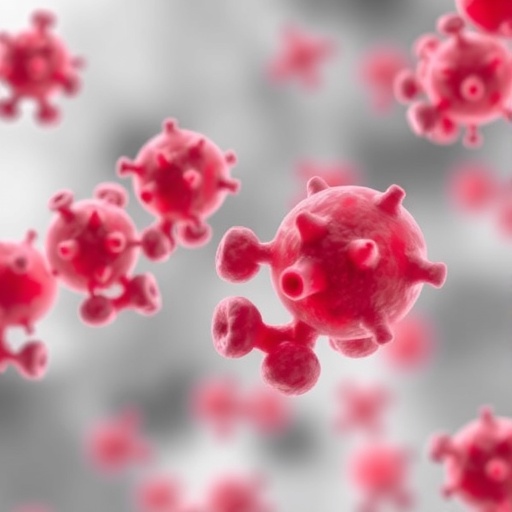In recent advancements in the understanding of metabolic diseases, a groundbreaking study has emerged, highlighting the intricate relationship between the neutrophil-to-high-density lipoprotein-cholesterol (HDL-C) ratio and the prevalence and mortality of diabetes. Conducted as a comprehensive cross-sectional study, this research sheds light on potential biomarkers that could significantly impact how clinicians approach diabetes diagnosis and management. The work of Tao et al. stands to reshape our interpretation of biochemical markers in the context of diabetes and offers new avenues for intervention.
Neutrophils are pivotal components of the immune system, and their response can indicate various inflammatory states. High-density lipoprotein cholesterol, often referred to as “good” cholesterol, plays a crucial role in lipid metabolism and cardiovascular health. The ratio of neutrophils to HDL-C could serve as a novel index, reflecting an individual’s inflammatory burden and metabolic health. This study posits that an elevated ratio might correlate with higher incidences of diabetes, presenting these findings in a manner that could shift clinical practices.
In the context of increasing diabetes prevalence globally, understanding the parameters that contribute to this metabolic disorder is imperative. Millions suffer from both type 1 and type 2 diabetes, creating a significant burden on healthcare systems. This study delineates a connection that could help identify individuals at risk of developing diabetes or those who may be facing dire health complications associated with the disease. Moreover, understanding how neutrophil and HDL-C levels interact offers insights into the underlying mechanisms of diabetes pathogenesis.
The researchers conducted their study on a substantial demographic, gathering data to analyze the significance of the neutrophil-to-HDL-C ratio effectively. Utilizing robust statistical methodologies, the investigators were able to discern patterns that indicate elevated ratios link to poorer metabolic profiles. Furthermore, the study takes into account confounding factors that could have skewed results, ensuring that observations regarding diabetes prevalence are reliable and valid.
One of the most compelling aspects of the study is its focus on mortality associated with diabetes. Historically, linking biomarkers to mortality has been challenging. However, this research suggests that patients exhibiting a high neutrophil-to-HDL-C ratio face increased risks of mortality, emphasizing the need for proactive monitoring of these values in diabetic patients. Understanding this correlation could ultimately enhance preventive strategies and patient outcomes.
The findings presented in this study call into question the traditional approaches toward assessing cardiovascular risks in diabetic patients. The implications extend beyond mere correlation; they suggest a direct pathway by which neutrophils and HDL-C could influence metabolic processes. This forms the basis for further investigations and perhaps clinical trials aimed at modulating these parameters to better control diabetes and its complications.
The aspect of inflammation in diabetes is not a new topic; however, the unique angle taken by the researchers provides a fresh perspective. By framing the discussion around a simple blood test that reveals the neutrophil-to-HDL-C ratio, there lies an opportunity for healthcare providers to integrate this into routine assessments. Such integration could make a significant difference in managing complications and improving quality of life for patients with diabetes.
In the tailwind of these findings, future research will likely explore therapeutic avenues to manipulate these ratios effectively. Could dietary interventions aimed at increasing HDL-C or reducing neutrophil counts yield beneficial effects on diabetic patients? These are the questions that researchers may delve into, driving the field forward. As diabetes continues to pose a challenge globally, the search for solutions becomes ever more critical.
Moreover, the comprehensive nature of the study is noteworthy. By inclusively analyzing various demographics, the findings offer generalizability that can benefit diverse populations across different geographic and socio-economic landscapes. The versatility of the neutrophil-to-HDL-C ratio as a biomarker means it could find its place in routine screening protocols and expand access to preventive care efforts.
This study emphasizes the interconnectedness of systemic inflammation and metabolic disorders. As more clinicians appreciate the relevance of these findings, there may be a paradigm shift in how diabetes and its accompanying risks are approached. The potential for improving patient care through awareness and understanding of this biomarker cannot be overstated and could herald a new age of predictive medicine.
In conclusion, the compelling evidence presented by Tao et al. opens the door to rethinking diabetes management strategies and tools. With the integration of neutrophil-to-HDL-C ratios into clinical practice, the healthcare landscape could evolve, ultimately leading to enhanced patient outcomes and reduced mortality rates associated with diabetes. The call to action lies with the medical community to embrace this insight and translate it into clinical practice, ensuring that patients receive the most informed and effective care possible.
As this research paves the way for future studies, it signifies the importance of continuous investigation into the relationships between biomarkers and diseases. Particularly, the interplay between inflammatory markers and chronic conditions like diabetes remains a fertile ground for discovery and innovation. The emerging knowledge will help inform clinical guidelines, patient education, and future investigations into viable therapeutic interventions aimed at improving the lives of those affected by diabetes.
The journey to unraveling diabetes’s complexities does not end with this study. It serves as a crucial step toward understanding how monitoring the neutrophil-to-HDL-C ratio could potentially change the landscape of diabetes management for better health outcomes across populations.
Subject of Research: Association between neutrophil-to-high-density lipoprotein-cholesterol ratio and prevalence and mortality of diabetes.
Article Title: Association between neutrophil-to-high-density lipoprotein-cholesterol ratio and prevalence and mortality of diabetes: a cross-sectional study.
Article References:
Tao, Y., Liu, Y., Guo, S. et al. Association between neutrophil-to-high-density lipoprotein-cholesterol ratio and prevalence and mortality of diabetes: a cross-sectional study.
BMC Endocr Disord 25, 163 (2025). https://doi.org/10.1186/s12902-025-01978-1
Image Credits: AI Generated
DOI: 10.1186/s12902-025-01978-1
Keywords: Neutrophil-to-HDL-C ratio, diabetes prevalence, diabetes mortality, biomarkers, inflammation, metabolic health.




